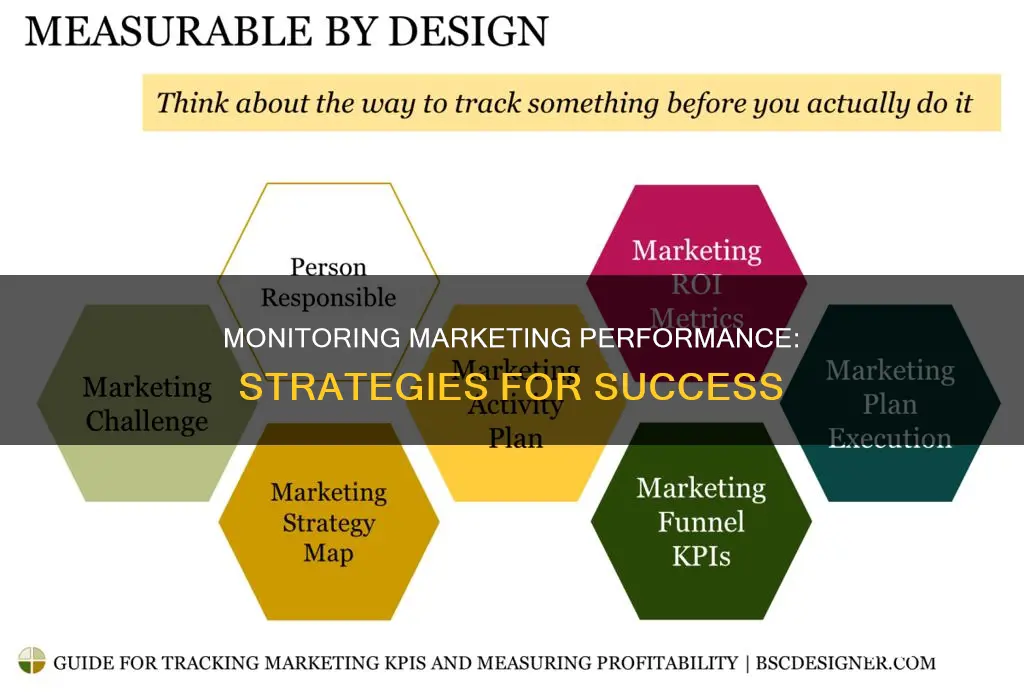
Monitoring the performance of a marketing plan is essential for businesses to understand the success of their campaigns and make data-driven decisions. By tracking key performance indicators (KPIs) and metrics, companies can evaluate the effectiveness of their marketing strategies, identify areas for improvement, and optimise their campaigns to increase sales and profits. This process involves setting clear goals, choosing the right tools for analysis, and regularly reviewing performance to make data-backed adjustments.
| Characteristics | Values |
|---|---|
| Set goals | Set SMART goals, i.e., goals that are specific, measurable, attainable, relevant, and timely. |
| Choose data-tracking software | Use tools like GA4, Google Search Console, MarketingCloudFX, etc. |
| Determine KPIs | Track metrics such as traffic, conversion, and revenue. |
| Create a schedule for tracking performance | Evaluate progress regularly and adjust strategies as needed. |
| Monitor ROI | Measure the return on investment to understand the profitability of marketing campaigns. |
| Monitor customer acquisition cost | Understand the cost of acquiring new customers in relation to revenue. |
| Monitor customer lifetime value | Measure the total revenue expected from a single customer account. |
| Monitor marketing channels | Understand the performance of different marketing channels such as social media, email marketing, etc. |
| Monitor customer satisfaction | Implement systems to track and respond to customer complaints and suggestions. |
| Monitor sales performance | Analyze sales data and take corrective actions to improve marketing performance. |
| Monitor marketing expenses | Calculate the marketing expense-to-sales ratio and track deviations using control charts. |
What You'll Learn

Set clear goals and objectives
Setting clear goals and objectives is the foundation of any marketing plan. Without clear goals, you lack direction and may end up pursuing vanity metrics that don't contribute to your business's success.
Marketing objectives are the outcomes a brand wants to generate from its marketing activities. They should be measurable and realistic, providing a strategic direction for your team to work towards. These objectives should also help you determine the specific marketing tactics and tasks you will use to achieve them.
- Use the SMART principle: Ensure your goals are Specific, Measurable, Achievable, Relevant, and Timely. For example, instead of "gain new leads," a SMART goal would be "increase the number of leads gained per month to 100 by the end of the quarter."
- Focus on your business objectives: Start with your overall business objectives and then determine the marketing objectives that will help you achieve them. For instance, if your business objective is to increase revenue, your marketing goal could be to attract more customers.
- Be specific: Clearly define what you want to achieve. Instead of saying "I want more sales," specify how much you want sales to increase, which channels will help you achieve this, and set a deadline.
- Make it measurable: Identify the Key Performance Indicators (KPIs) that will help you understand whether you've reached your goals. For example, if your goal is to increase brand awareness, you can measure social media follower counts, the number of online brand mentions, or direct traffic to your website.
- Ensure achievability: While it's good to aim high, make sure your goals are realistic and achievable. Otherwise, you're setting yourself up for failure.
- Relevance is key: Your marketing goals should be relevant to your brand mission and contribute to your overall business goals. For example, increasing brand awareness can lead to improved brand reputation and higher customer satisfaction rates, resulting in higher long-term revenue.
- Set a timeline: Giving your objectives a clear deadline helps you measure results and benchmark them against past and future campaigns. This also helps you optimize your strategies and objectives for better results in the future.
By setting clear goals and objectives, you can effectively monitor the performance of your marketing plan and make adjustments as needed to achieve success.
Hooking Stage Monitors to a Presonus Digital Soundboard
You may want to see also

Track key performance indicators (KPIs)
Tracking key performance indicators (KPIs) is essential for understanding the effectiveness of your marketing campaigns and attributing revenue to them. However, only 23% of marketers are confident they are tracking the right KPIs.
KPIs are quantifiable values used to measure how effectively you have reached a business target over a specified period. They are critical for marketing teams to prove their direct and indirect impact on leads and sales.
- Return on Investment (ROI): This is a key metric for understanding how much profit has been generated from your marketing campaigns. It is calculated by subtracting costs from profits.
- Cost per Sale/Lead: This metric breaks down the ROI to measure the marketing cost for each individual sale or lead. It is calculated by dividing the marketing campaign budget by the number of sales or leads generated.
- Conversion Rate: This measures how many leads convert into sales, sign-ups, etc. It is a good indicator of how well your marketing activities are working to get the desired response from your audience.
- Customer Lifetime Value (CLV): This is the total revenue expected from a single customer account. It is calculated by multiplying the average number of purchases per year by the average number of years a customer purchases products from the company.
- Customer Acquisition Cost (CAC): CAC is the sum of all costs associated with acquiring a new customer. It helps marketers understand which customer segments are most profitable.
- Return on Ad Spend (ROAS): ROAS quantifies the revenue generated for every dollar spent on advertising. It is an important lever for revenue growth.
- Click-Through Rate (CTR): CTR measures the percentage of people who click on a link after viewing a web page, advertisement, or social media post. It is a good indicator of how well your message is resonating with your target audience.
- Content Engagement: This metric tracks all likes, shares, comments, and clicks on your social media content, helping you understand if your content is "sticky" and engaging your audience.
- Average Time on Page: This metric, found in Google Analytics, shows the average time spent on a single page and can indicate whether users are engaging with your message.
Adjusting Monitor Settings to Remove Red Tint
You may want to see also

Choose data-tracking software
Choosing the right data-tracking software is essential to monitor the performance of your marketing plan. Here are some tips to help you select the best software for your needs:
- Identify your requirements: Start by defining the specific marketing analytics features you need. Do you want software that focuses on web analytics, social media analytics, or email marketing analytics? Do you require tools for lead management and nurturing? Do you want to track customer behaviour across websites and mobile apps? Understanding your requirements will help you narrow down the options.
- Consider compatibility: Think about the other tools you use and look for data-tracking software that integrates seamlessly with them. For example, CRM systems, email marketing platforms, and content management systems. Ensuring compatibility will enable you to centralise data and streamline your workflows.
- Evaluate usability: Choose software with an intuitive and user-friendly interface. Consider the level of customisation you need and whether you require advanced features like drag-and-drop report builders and custom dashboards. Also, assess the level of technical expertise required to use the software effectively.
- Assess data visualisation capabilities: Look for software that offers visual summaries of your marketing performance through charts, graphs, and maps. Data visualisation makes complex data sets easier to understand and allows you to communicate insights effectively to stakeholders.
- Explore automation features: Automation can save you time and effort by automating repetitive tasks. For example, automated reporting can generate and distribute reports to relevant stakeholders without manual intervention.
- Review pricing and value: Data-tracking software can vary significantly in price. Consider your budget and the value the software will bring to your business. Some software providers offer free versions or trials, allowing you to test their platform before committing.
- Google Analytics (GA4): Tracks user interactions with your site and ads, including event hits, e-commerce purchases, and traffic acquisition. It's free and offers valuable insights.
- Google Search Console (GSC): A free tool from Google that helps track your website's SEO performance. It provides data on impressions, clicks, click-through rates, and your site's position in search results.
- MarketingCloudFX: A platform that enables you to manage marketing campaigns, track leads, measure email campaign results, and monitor search engine performance.
- Ruler Analytics: Tracks the entire customer journey, attributing revenue to specific marketing touchpoints. It integrates with various tools, including Google Ads and Analytics, and offers machine learning-based impression attribution.
- DashThis: Allows users to create custom dashboards and reports, with templates available for common reports. Offers automated report generation and scheduling.
- HighLevel: A comprehensive platform that includes a CRM system, lead capture, appointment scheduling, and real-time dashboards.
- Social Status: Focuses on social media performance tracking across multiple platforms, including Facebook, Instagram, TikTok, LinkedIn, and YouTube. Offers automated reporting and competitor and influencer analytics capabilities.
- Brand24: Tracks brand mentions, audience sentiment, and engagement across the web and social media. Provides real-time alerts and influencer scoring.
- Adjust: Optimises mobile marketing campaigns by tracking user journeys and identifying the best-performing marketing channels. Includes advanced mobile attribution capabilities and comprehensive fraud prevention.
- Whatagraph: Emphasises ease of use with an intuitive drag-and-drop report builder. Offers automated report scheduling and multi-channel reporting capabilities.
- Looker: Part of the Google Cloud suite, Looker provides detailed customer data reports and enables in-depth data exploration and visualisation.
- TapClicks: Centralises and consolidates data from multiple sources, providing a comprehensive view of e-commerce performance. Includes advanced reporting and visualisation capabilities.
- Marketo: Excels in marketing lead management, with robust lead scoring and nurturing capabilities. Provides detailed insights into lead behaviour and advanced reporting features.
- Infor Birst: Offers pre-built industry and role-specific templates, saving time and providing relevant metrics for specific industries and roles within marketing.
Remember, the right data-tracking software will depend on your unique needs. Carefully evaluate the features, compatibility, usability, and pricing to make an informed decision.
Studio Monitor Stands: Which Ones Should I Buy?
You may want to see also

Measure return on investment (ROI)
Measuring the return on investment (ROI) is a crucial aspect of evaluating the performance of your marketing plan. It involves attributing profit and revenue growth to the impact of your marketing initiatives, allowing you to determine whether your marketing efforts are contributing to the company's bottom line. Here are some detailed steps and considerations to help you measure ROI effectively:
Set Clear Goals
Begin by setting clear and specific goals for your marketing campaigns. These goals should align with your overall business objectives and be measurable, attainable, and timely. For example, instead of simply aiming to "gain new leads," a SMART goal would be to "increase the number of leads gained per month to 100 by the end of the quarter."
Choose the Right Metrics
Select the key performance indicators (KPIs) that align with your marketing goals. These KPIs could include metrics such as traffic sources, total site visits, conversion rates, cost per acquisition, and, of course, ROI. By choosing the right metrics, you can track your progress and make data-driven adjustments to your campaigns.
Utilize Data-Tracking Software
Take advantage of data-tracking software and analytics tools to measure your marketing campaign's performance. Tools like Google Analytics, Google Search Console, and MarketingCloudFX can provide valuable insights into how users interact with your website, your SEO performance, and the effectiveness of your email campaigns.
Calculate Marketing ROI
To calculate Marketing ROI, you can use the following formula:
Sales Growth - Marketing Cost) / Marketing Cost = Marketing ROI
However, it's important to note that this formula assumes that all sales growth is solely due to marketing efforts. For a more accurate understanding, you should account for organic sales growth:
Sales Growth - Organic Sales Growth - Marketing Cost) / Marketing Cost = Marketing ROI
Additionally, you can further refine your ROI calculation by considering total revenue, gross profit, and net profit:
- Total Revenue: Look at the holistic picture by considering the total revenue generated from a campaign.
- Gross Profit: Understand the revenue generated in relation to the cost of producing or delivering goods and services.
- Net Profit: Dive deeper by calculating the impact on net profit by subtracting additional expenses.
Understand Customer Lifetime Value (CLV)
Customer Lifetime Value (CLV) is a crucial metric that sheds light on the long-term value of customer relationships. It can be calculated using the formula:
Customer Lifetime Value = (Retention Rate) / (1 + Discount Rate / Retention Rate)
Compare Against Industry Standards
Compare your marketing ROI against industry standards and benchmarks to assess your performance. The rule of thumb for marketing ROI is typically a 5:1 ratio, with exceptional ROI considered around a 10:1 ratio. Anything below a 2:1 ratio is generally considered unprofitable.
Establish Clear ROMOs
As established by Rex Briggs in the book "What Sticks: Why Most Advertising Fails and How to Guarantee Yours Succeeds," it's important to consider Return-On-Marketing-Objectives (ROMOs). These are external factors that contribute to the success of a campaign beyond just ROI, such as changing brand perception or awareness.
Leverage a Marketing Analytics Platform
Utilize a marketing analytics platform that can unify disparate attributions and provide holistic and granular insights. This will enable you to track consumers across various channels and touchpoints, giving you a clearer understanding of your marketing performance.
Viewing Your Website: Monitor Size Matters
You may want to see also

Monitor customer satisfaction
Monitoring customer satisfaction is a key part of understanding the performance of your marketing plan. Here are some ways to monitor customer satisfaction:
Surveys
A common way to monitor customer satisfaction is through surveys. There are a few different types of customer satisfaction surveys:
- Customer Satisfaction Score (CSAT): This is the most commonly used measurement for customer satisfaction. Customers are asked to rate their satisfaction on a linear scale, usually from 1 to 5.
- Customer Effort Score (CES): This is similar to CSAT, but instead of asking about satisfaction, you ask customers to gauge the ease of their experience.
- Net Promoter Score (NPS): NPS asks the question, "How likely is it that you would recommend this company to a friend or colleague?".
When creating a survey, it's important to keep the questions concise and relevant, and to avoid leading questions. You should also consider the timing and frequency of your surveys, sending them at meaningful points in the customer lifecycle, such as after a key moment in their journey.
Social Media
Social media can be a valuable channel for monitoring customer satisfaction. Customers can easily provide feedback and share their perceptions of your brand and products. Monitoring social media mentions and analysing fluctuations in followers, shares, and likes can give you insights into customer satisfaction and loyalty.
Website Analytics
By analysing website traffic and content engagement, you can gain insights into customer satisfaction. For example, tracking the time spent on your website, the number of page views, and the bounce rate can indicate whether customers are finding your content valuable and engaging.
Direct Feedback
Encouraging customers to share their feedback through direct channels, such as live chat, email, or phone conversations, can provide valuable insights. It's important to analyse these interactions and identify areas where you can improve the customer experience.
Indirect Feedback
In addition to direct feedback, it's important to consider indirect feedback, such as customer behaviour and purchase patterns. Analysing metrics such as customer retention, repurchase rates, and churn rate can provide insights into customer satisfaction and loyalty.
By utilising these methods and analysing the data, you can gain a comprehensive understanding of customer satisfaction and make informed decisions to improve your marketing plan.
Is a 2K Monitor Worthwhile for GTX 980M Users?
You may want to see also
Frequently asked questions
Your goals should be SMART: specific, measurable, attainable, relevant, and timely. For example, a SMART goal would be "increase the number of leads gained per month to 100 by the end of the quarter."
Important metrics include return on investment (ROI), cost per sale, cost per lead, conversion rate, and customer lifetime value (CLV).
Some tools you can use are Google Analytics, Google Search Console, and MarketingCloudFX.







